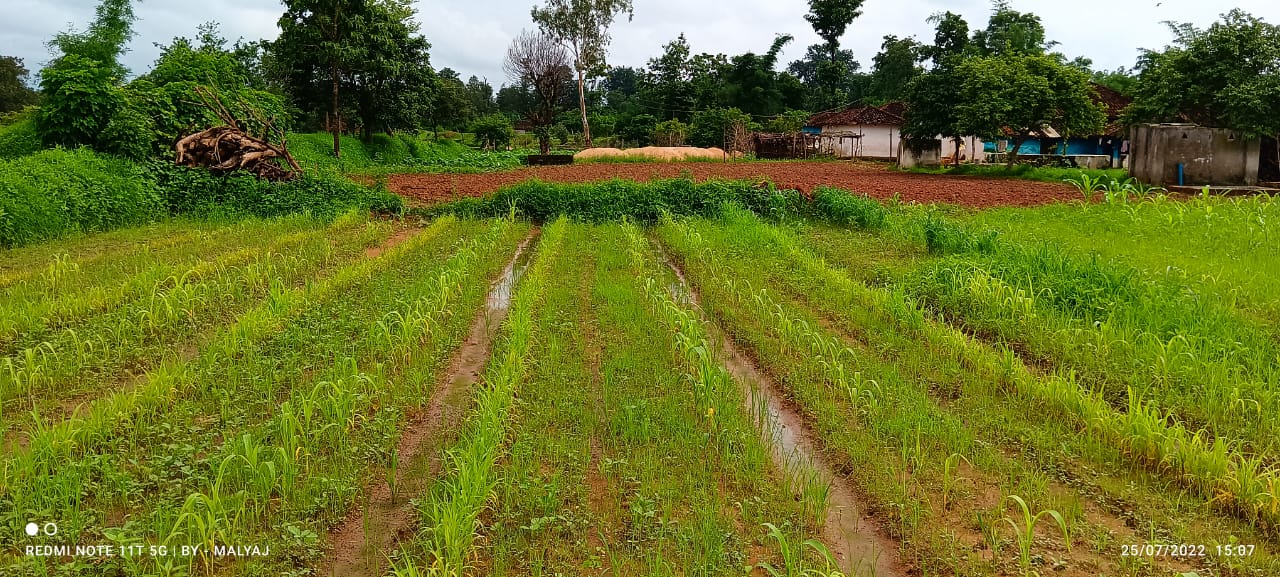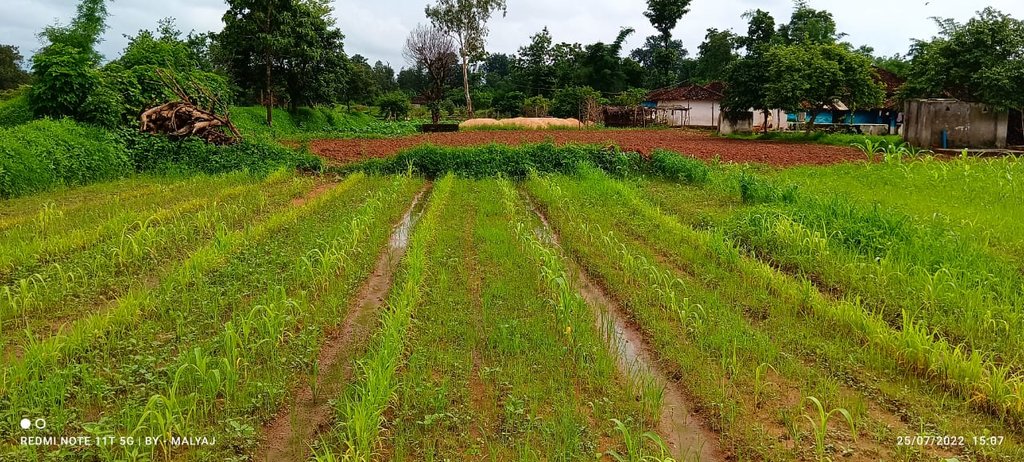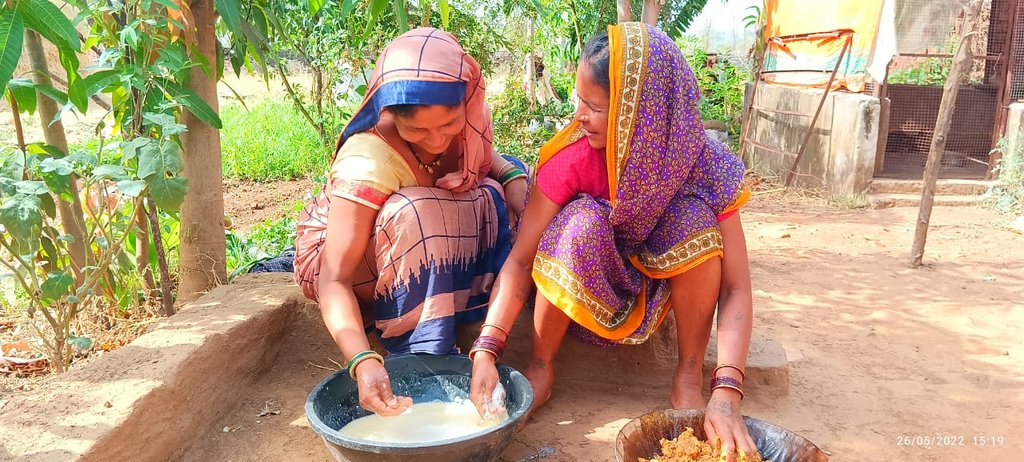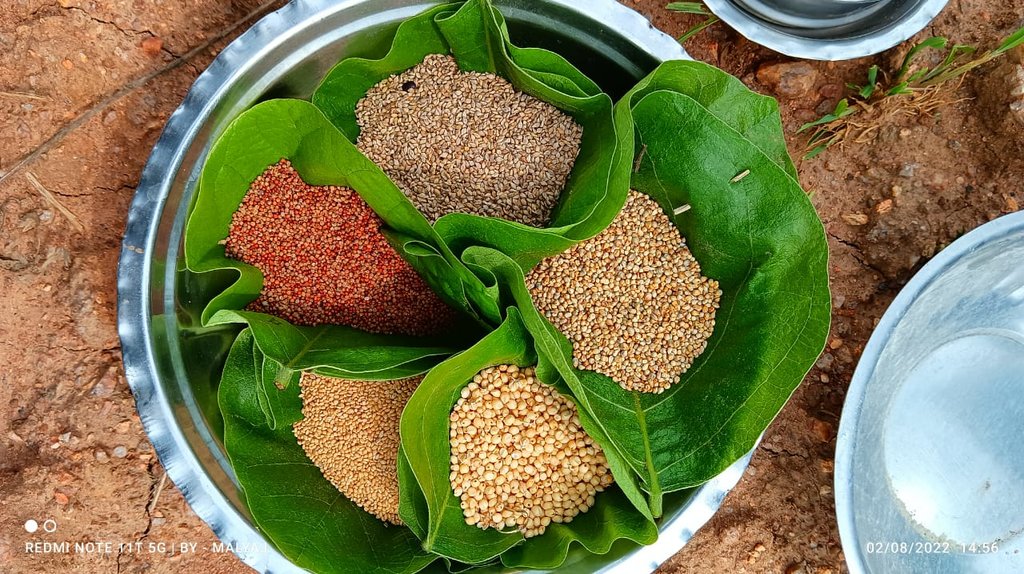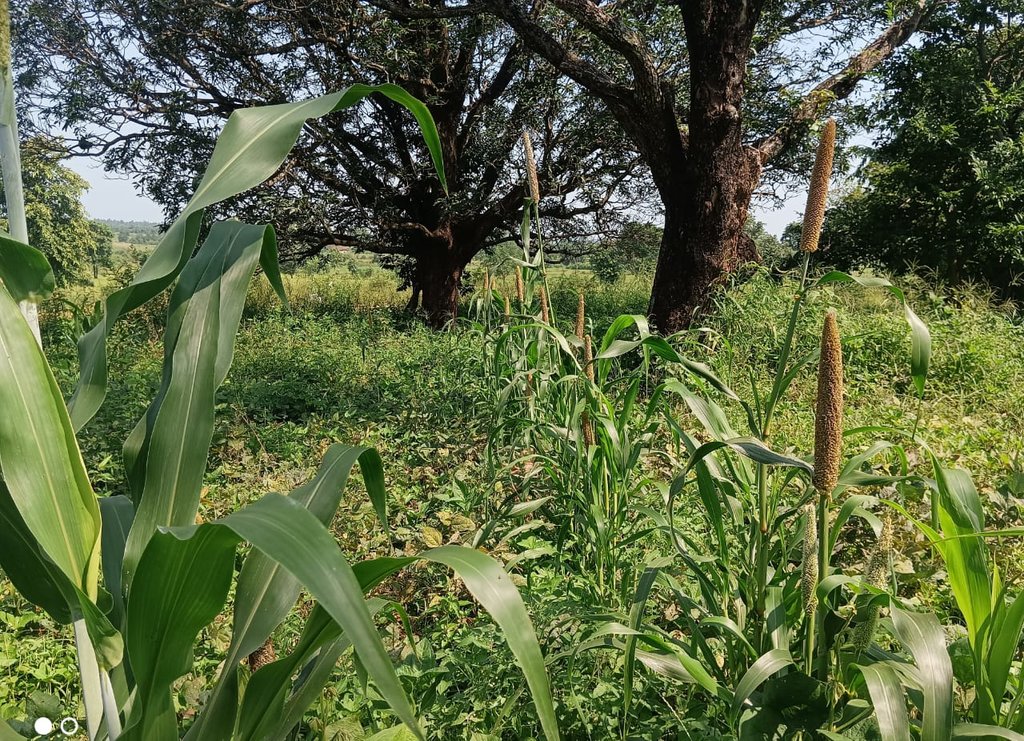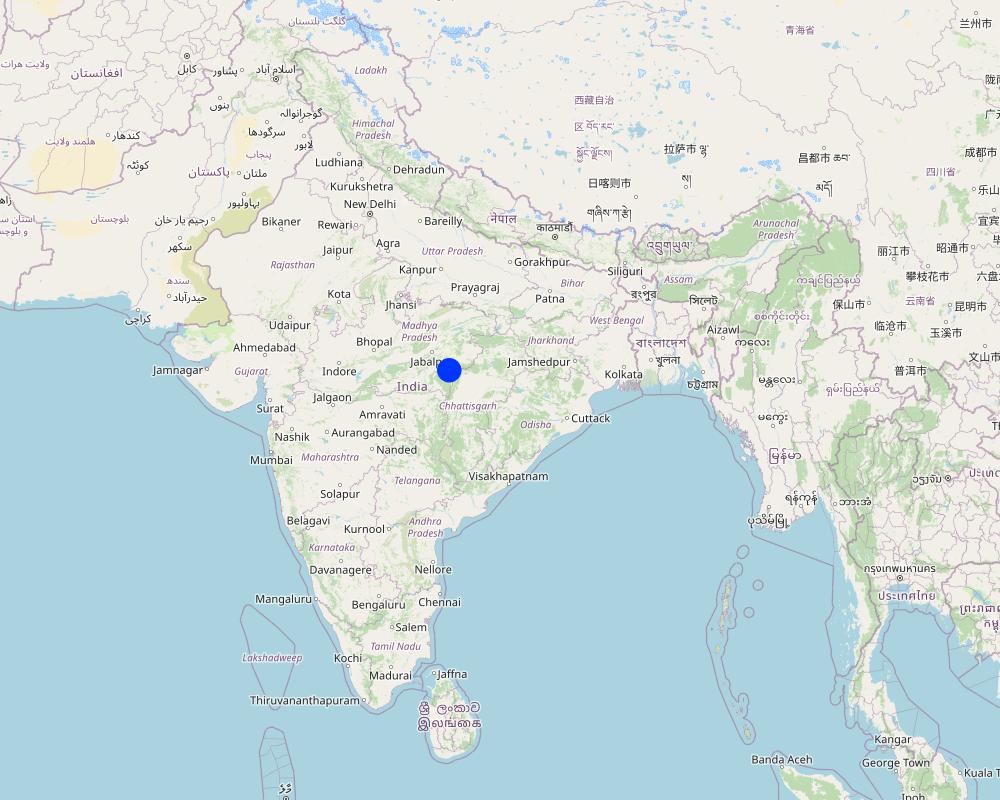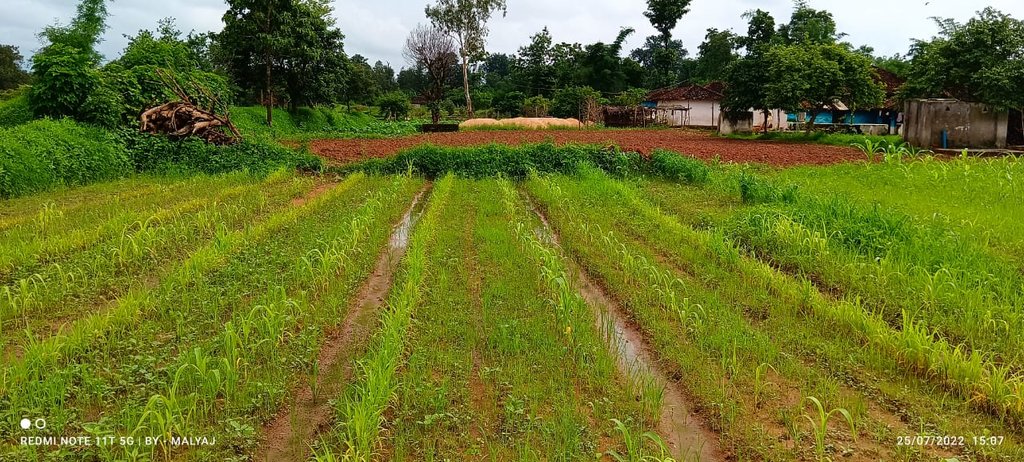Pre-Monsoon Dry Sowing (PMDS) [India]
- Creation:
- Update:
- Compiler: Santosh Gupta
- Editors: Noel Templer, Stephanie Katsir, Kim Arora, Tabitha Nekesa, Ahmadou Gaye, Siagbé Golli
- Reviewers: Udo Höggel, Sally Bunning
technologies_6697 - India
View sections
Expand all Collapse all1. General information
1.2 Contact details of resource persons and institutions involved in the assessment and documentation of the Technology
Name of project which facilitated the documentation/ evaluation of the Technology (if relevant)
Soil protection and rehabilitation for food security (ProSo(i)l)Name of the institution(s) which facilitated the documentation/ evaluation of the Technology (if relevant)
GIZ India (GIZ India) - IndiaName of the institution(s) which facilitated the documentation/ evaluation of the Technology (if relevant)
Alliance Bioversity and International Center for Tropical Agriculture (Alliance Bioversity-CIAT) - KenyaName of the institution(s) which facilitated the documentation/ evaluation of the Technology (if relevant)
Ecociate Consultants (Ecociate Consultants) - India1.3 Conditions regarding the use of data documented through WOCAT
The compiler and key resource person(s) accept the conditions regarding the use of data documented through WOCAT:
Yes
1.4 Declaration on sustainability of the described Technology
Is the Technology described here problematic with regard to land degradation, so that it cannot be declared a sustainable land management technology?
No
Comments:
The technology described here is related to sustainable land and other resource management systems.
2. Description of the SLM Technology
2.1 Short description of the Technology
Definition of the Technology:
The Pre-Monsoon Dry Sowing Technology aims to sow 12 to 15 different crop varieties in April without waiting for rain. To achieve this the seeds are pelletized with a mixture of clay soils, bio-inoculants like dried Ghanjeevamruth and Dravajeevamrit, and ash. The main objective of this technology is to empower rainfed farmers by utilizing the initial rainfall in April and May for crop cultivation. By using pelettized seeds, they can maximize the effectiveness of rainfall showers before the arrival of the monsoon season. Such seeds can also survive, if there are delay in the rainfall as the pellets around the seed help it in maintaining the moisture.
2.2 Detailed description of the Technology
Description:
Pre-monsoon dry sowing (PMDS) is a system of sowing, tilling and tending the land wherein the farmer grows crops in non-farming seasons or whenever there is no crop cover on the land. This can be practised before the advent of monsoon, during summer (April-May), after Kharif and before the beginning of the Rabi season (September and October). PMDS harnesses the water vapor from air that gets settled in the form of early morning dew. The dew supplies the required moisture to the soil. (Reference:-https://apcnf.in/wp-content/uploads/2022/05/IDS-2020-2021-APCNF-PMDS-Report.pdf)
In the study where PMDS was practised before the onset of the monsoon season, typically during the dry month of April. The seeds are pelletized with a mixture of clay soils, bio-inoculants, and ash, which creates a protective coating around the seed and helps it to germinate even in the case of delayed rains or very little rainfall. The coating around the seed, helps it to maintain moisture and support its germination. As the name suggests, the technology is good for utilising the pre-monsoon season by advancing the sowing cycles, using the usually dry months of summer and utilising the pre-monsoon rains.
This technology benefits rainfed areas where farmers rely solely on rainfall for irrigation. PMDS aims to promote an extended duration of crop cover under rainfed conditions, allowing farmers to cultivate crops with a reduced risk of crop failure in the cases of delayed or lower rainfall. Since seeds are germinated before the arrival of monsoon, there are times when they can also survive the heavy rains. This technology is useful in utilising moisture to the best extent possible as seeds are covered with the outer layer of clay and other stuff. In the Mandla District of Madhya Pradesh, farmers utilized seeds from their homes, comprising 12 to 15 crops, including cereals, pulses, and spices. These collected seeds were pelletized, dried for 24 hours, and broadcasted into minimally tilled soil. The diversified crop combination was grown until July and mixed with the soil before paddy transplanting. This process improves the soil's microbial activity, resulting in increased yields in crops grown before paddy and in the paddy crop itself. Therefore, the farmers benefit from increased production and yields through this technique of PMDS.
PMDS not only improves the economics of farmers but it also improves soil health. The covering of the soil with different crops protects it from heat, pounding rain, and wind. It also improves diversity in soil microorganisms, beneficial insects and other species. Covering soil for 365 days with plant diversity is also critical to protect soil health and balance climate change. PMDS can facilitate all these functions.
2.3 Photos of the Technology
2.5 Country/ region/ locations where the Technology has been applied and which are covered by this assessment
Country:
India
Region/ State/ Province:
Madhya Pradesh
Further specification of location:
Bichhiya block
Specify the spread of the Technology:
- applied at specific points/ concentrated on a small area
Is/are the technology site(s) located in a permanently protected area?
No
Comments:
The technology is applied by rainfed farmers in the Mandla District of Madhya Pradesh.
Map
×2.6 Date of implementation
Indicate year of implementation:
2022
2.7 Introduction of the Technology
Specify how the Technology was introduced:
- during experiments/ research
- through projects/ external interventions
Comments (type of project, etc.):
The modified PMDS technology used in another program, the Andhra Pradesh Natural Farming Program, has been adopted here.
3. Classification of the SLM Technology
3.1 Main purpose(s) of the Technology
- improve production
- reduce, prevent, restore land degradation
- preserve/ improve biodiversity
- adapt to climate change/ extremes and its impacts
- create beneficial economic impact
3.2 Current land use type(s) where the Technology is applied
Land use mixed within the same land unit:
No

Cropland
- Annual cropping
Annual cropping - Specify crops:
- cereals - rice (wetland)
Number of growing seasons per year:
- 1
Specify:
Generally, Paddy is transplanted in July Month in the Mandla District and harvested around November. This region is majorly rainfed, and only 9% of the area has some irrigation source.
Is intercropping practiced?
No
Is crop rotation practiced?
No
3.3 Has land use changed due to the implementation of the Technology?
Has land use changed due to the implementation of the Technology?
- Yes (Please fill out the questions below with regard to the land use before implementation of the Technology)
Land use mixed within the same land unit:
No

Cropland
- Annual cropping
Annual cropping - Specify crops:
- cereals - maize
- cereals - sorghum
- legumes and pulses - lentils
- Lentils include - Black gram, Cowpea, Green Gram, Red Gram and Oil seeds including sesame and Coriander.
Is intercropping practiced?
Yes
If yes, specify which crops are intercropped:
The above mention crops are generally mixed together and grown on the same patches of land in April.
Is crop rotation practiced?
No
Comments:
The PMDS technology has enabled crop diversification in the Mandla District from April to July.
3.4 Water supply
Water supply for the land on which the Technology is applied:
- rainfed
3.5 SLM group to which the Technology belongs
- improved ground/ vegetation cover
- minimal soil disturbance
- integrated soil fertility management
3.6 SLM measures comprising the Technology

agronomic measures
- A1: Vegetation/ soil cover
- A2: Organic matter/ soil fertility
- A6: Residue management
A6: Specify residue management:
A 6.4: retained

management measures
- M1: Change of land use type
- M2: Change of management/ intensity level
Comments:
The PMDS (pre-monsoon dry sowing) technique involves crop diversification and the utilization of rainfed land from April to July, typically left unused, to improve soil health. This is achieved by planting green crops that are later harvested, leaving the crop biomass in the soil to retain moisture, and subsequently growing paddy crops on the same land. This approach has the added benefit of increasing yields, improving crop quality, and reducing farmers' reliance on only one single crop.
3.7 Main types of land degradation addressed by the Technology

soil erosion by water
- Wt: loss of topsoil/ surface erosion

physical soil deterioration
- Pc: compaction
- Pu: loss of bio-productive function due to other activities

biological degradation
- Bc: reduction of vegetation cover
Comments:
Mandla district receives rainfall of around 1500mm, and soil is highly susceptible to erosion. Covering the soil with different crops reduces the erosion potential, and mixing the soil with biomass improves soil health.
3.8 Prevention, reduction, or restoration of land degradation
Specify the goal of the Technology with regard to land degradation:
- prevent land degradation
- reduce land degradation
Comments:
Land degradation by water erosion is reduced by covering the topsoil with crops for an extended duration. The addition of crop biomass improves soil health.
4. Technical specifications, implementation activities, inputs, and costs
4.1 Technical drawing of the Technology
Technical specifications (related to technical drawing):
PMDS was undertaken at various sizes of plots based on the availability of land with farmers. Some farmers did at 0.10 acres of land while others did at 2 acres. Also, there was no fixed pattern that was followed for the quantity and variety of seeds. Whatever seeds were available were sown. In the image above, it can be seen that the field where PMDS was undertaken has multiple crops at different stages of their growth while the area with no PMDS has no crop and fallow red soil can be seen.
Author:
Santosh
Date:
22/02/2023
4.2 General information regarding the calculation of inputs and costs
Specify how costs and inputs were calculated:
- per Technology area
Indicate size and area unit:
1 acre
other/ national currency (specify):
INR (March, 2023)
If relevant, indicate exchange rate from USD to local currency (e.g. 1 USD = 79.9 Brazilian Real): 1 USD =:
82.5
Indicate average wage cost of hired labour per day:
204 INR
4.3 Establishment activities
Comments:
There are no establishment activities under the PMDS.
4.4 Costs and inputs needed for establishment
Comments:
There are no establishment costs required for PMDS as it's only a sowing activity. Farmers do hire agriculture equipments to undertake the activity.
4.5 Maintenance/ recurrent activities
| Activity | Timing/ frequency | |
|---|---|---|
| 1. | Collection of seeds | 1 month before the onset of Monsoon (mid May in project area) |
| 2. | Seed treatment and preparation of seed balls | End of May in project area |
| 3. | Broadcasting of the seed balls | End of May in project area |
| 4. | Soil rotation | 2-3 days after the broadcasting of seed balls |
| 5. | Harvesting of leafy vegetables, fodder and other produces | Mid of June to mid of July |
| 6. | Mixing the green manure in soils | End of July or before transplantation of rice |
4.6 Costs and inputs needed for maintenance/ recurrent activities (per year)
| Specify input | Unit | Quantity | Costs per Unit | Total costs per input | % of costs borne by land users | |
|---|---|---|---|---|---|---|
| Labour | Seed treatment, preparation of seed balls | Person days | 1.0 | 200.0 | 200.0 | 100.0 |
| Labour | Broadcasting of seeds | Person days | 1.0 | 200.0 | 200.0 | 100.0 |
| Labour | Harvesting of the crops | Person days | 2.0 | 150.0 | 300.0 | 100.0 |
| Equipment | Agriculture equipment for soil rotation | Hour | 0.5 | 600.0 | 300.0 | 100.0 |
| Equipment | Cultivator | Hour | 1.0 | 600.0 | 600.0 | 100.0 |
| Plant material | Seeds of different crops | kg | 6.0 | 75.0 | 450.0 | 100.0 |
| Fertilizers and biocides | Bio-inputs | LS | 1.0 | 400.0 | 400.0 | 100.0 |
| Total costs for maintenance of the Technology | 2450.0 | |||||
| Total costs for maintenance of the Technology in USD | 29.7 | |||||
Comments:
Technical inputs were provided from the project around the seed treatment, sowing, and monitoring of the crops.
4.7 Most important factors affecting the costs
Describe the most determinate factors affecting the costs:
Availability of seeds, bio-inputs, and rainfall pattern. Usually, there are rains during the pre-monsoon season in the project area, however, in case of no rains at all during the entire summer, farmers may not be in a position to achieve the desired results.
5. Natural and human environment
5.1 Climate
Annual rainfall
- < 250 mm
- 251-500 mm
- 501-750 mm
- 751-1,000 mm
- 1,001-1,500 mm
- 1,501-2,000 mm
- 2,001-3,000 mm
- 3,001-4,000 mm
- > 4,000 mm
Specify average annual rainfall (if known), in mm:
1427.00
Specifications/ comments on rainfall:
Monsoon season is from June-September, which has the majority of the rainfall.
Indicate the name of the reference meteorological station considered:
District at glance report of Ministry of Water Resources, Central Groundwater Board, North Central Region BHOPAL, 2013
Agro-climatic zone
- sub-humid
- semi-arid
The National Bureau of Soil Survey & Land Use Planning (NBSS&LUP) developed twenty agroecological zones based on the growing period as an integrated criterion of adequate rainfall, and soil groups. It delineated boundaries adjusted to district boundaries with a minimal number of regions. Mandla District of Madhya Pradesh lies in a Hot subhumid ecoregion with red and black soil. Precepitation - 1000–1500mm; Potential evapotranspiration -1300–1500 mm; Length of growing period-150–180days.
5.2 Topography
Slopes on average:
- flat (0-2%)
- gentle (3-5%)
- moderate (6-10%)
- rolling (11-15%)
- hilly (16-30%)
- steep (31-60%)
- very steep (>60%)
Landforms:
- plateau/plains
- ridges
- mountain slopes
- hill slopes
- footslopes
- valley floors
Altitudinal zone:
- 0-100 m a.s.l.
- 101-500 m a.s.l.
- 501-1,000 m a.s.l.
- 1,001-1,500 m a.s.l.
- 1,501-2,000 m a.s.l.
- 2,001-2,500 m a.s.l.
- 2,501-3,000 m a.s.l.
- 3,001-4,000 m a.s.l.
- > 4,000 m a.s.l.
Indicate if the Technology is specifically applied in:
- not relevant
Comments and further specifications on topography:
Bichhiya is a block in the Mandla district characterized by diverse topography. The block is located in the southern part of the District and is situated in the foothills of the Satpura range.
The topography of the Bichhiya block is hilly. The block has an average elevation of around 550 meters above sea level. The hills are covered with forests and are rich in flora and fauna.
The region has several small streams and tributaries that flow through it, which are mostly seasonal and originate in the hills.
5.3 Soils
Soil depth on average:
- very shallow (0-20 cm)
- shallow (21-50 cm)
- moderately deep (51-80 cm)
- deep (81-120 cm)
- very deep (> 120 cm)
Soil texture (topsoil):
- coarse/ light (sandy)
Soil texture (> 20 cm below surface):
- medium (loamy, silty)
Topsoil organic matter:
- low (<1%)
5.4 Water availability and quality
Ground water table:
5-50 m
Availability of surface water:
medium
Water quality (untreated):
poor drinking water (treatment required)
Water quality refers to:
both ground and surface water
Is water salinity a problem?
No
Is flooding of the area occurring?
No
Comments and further specifications on water quality and quantity:
The region has several small streams and tributaries that flow through it, primarily seasonal and originating in the hills. The area is also known for its waterfalls, including the Patalpani waterfall, a popular tourist destination.
5.5 Biodiversity
Species diversity:
- high
Habitat diversity:
- high
Comments and further specifications on biodiversity:
The area is surrounded by Kasha National Park and Phen Wildlife Sanctuary, with a good presence of forest area. Thus biodiversity is outstanding.
5.6 Characteristics of land users applying the Technology
Sedentary or nomadic:
- Sedentary
Market orientation of production system:
- mixed (subsistence/ commercial)
Off-farm income:
- > 50% of all income
Relative level of wealth:
- poor
Individuals or groups:
- individual/ household
Level of mechanization:
- manual work
- animal traction
Gender:
- women
- men
Age of land users:
- youth
- middle-aged
Indicate other relevant characteristics of the land users:
Bichhiya block has a significant tribal population. According to the 2011 Census of India, the block has a total population of around 47,000, of which approximately 41% are classified as Scheduled Tribes (STs). The powerful tribes inhabiting the region include the Gonds, Baigas, and Korkus.
5.7 Average area of land used by land users applying the Technology
- < 0.5 ha
- 0.5-1 ha
- 1-2 ha
- 2-5 ha
- 5-15 ha
- 15-50 ha
- 50-100 ha
- 100-500 ha
- 500-1,000 ha
- 1,000-10,000 ha
- > 10,000 ha
Is this considered small-, medium- or large-scale (referring to local context)?
- small-scale
5.8 Land ownership, land use rights, and water use rights
Land ownership:
- individual, titled
Land use rights:
- individual
Water use rights:
- communal (organized)
- individual
Are land use rights based on a traditional legal system?
Yes
5.9 Access to services and infrastructure
health:
- poor
- moderate
- good
education:
- poor
- moderate
- good
technical assistance:
- poor
- moderate
- good
employment (e.g. off-farm):
- poor
- moderate
- good
markets:
- poor
- moderate
- good
energy:
- poor
- moderate
- good
roads and transport:
- poor
- moderate
- good
drinking water and sanitation:
- poor
- moderate
- good
financial services:
- poor
- moderate
- good
6. Impacts and concluding statements
6.1 On-site impacts the Technology has shown
Socio-economic impacts
Production
crop production
Comments/ specify:
Based on the discussion with land users and implanting agency, production of the main crop (Paddy) increased by 20-25%. (The crop combination under PMDS has some nitrogen-fixing crops and the crop biomass improves the nutrient availability for the next crop which is paddy, also the better moisture helped the improvement in productivity of paddy crop as well.). Additional production from crops sown in April month was generated. An impact assessment study to document the quantifiable results has not been conducted so far.
risk of production failure
Comments/ specify:
Risk of of production failure reduced due to crop diversification
product diversity
Comments/ specify:
Crop diversification by sowing multi crops of cereals, millets, pulses, and oilseeds in otherwise paddy predominant area
production area
Comments/ specify:
The gross sown area increased as the land was brought under cultivation from April to July
land management
Comments/ specify:
Through this technology crop biomass was added to improve soil to improve its organic content and structure
Income and costs
farm income
Comments/ specify:
Increase in farm income due to additional crop production and increase in yield of the main crop
diversity of income sources
Comments/ specify:
12 to 15 different crops are grown in PMDS, reducing the crop failure chances and improvements in soil structure, therefore storing the soil moisture for an extended duration
Socio-cultural impacts
food security/ self-sufficiency
Comments/ specify:
Diversity in crops will reflect in increased and more diverse food availability
Ecological impacts
Water cycle/ runoff
evaporation
Comments/ specify:
Reduction in evaporation loss from April to July and effective utilization of soil moisture and rainfall in this duration
Soil
soil moisture
Comments/ specify:
Improved soil structure due to the addition of crop biomass in the soil leads to the retention of soil moisture. The extended duration of crop cover also reduces evaporation losses.
soil cover
Comments/ specify:
Extended duration of crop cover from April - July
soil loss
Comments/ specify:
Reduction in soil loss due to crop cover
nutrient cycling/ recharge
Comments/ specify:
Crop biomass increases organic carbon in the soil improving the availability of nutrient in the soil
Biodiversity: vegetation, animals
Vegetation cover
Comments/ specify:
Extended duration of vegetation cover of the soil
biomass/ above ground C
Comments/ specify:
Increase in biomass above ground by using pre-monsoon rainfall
plant diversity
Comments/ specify:
12-15 different crops are sown togehter
Climate and disaster risk reduction
micro-climate
Specify assessment of on-site impacts (measurements):
All the impacts indicated here are based on the discussions with land users and implementing agency. The reported outcomes are based on eye observations and estimations. Some of the impacts are also based on the reports and secondary documents published on the PMDS.
6.2 Off-site impacts the Technology has shown
Specify assessment of off-site impacts (measurements):
PMDS method is farmland-specific technology wherein effective utilization of natural resources (land and rainfall) is done. Therefore no direct off site impact of the technology is observed.
6.3 Exposure and sensitivity of the Technology to gradual climate change and climate-related extremes/ disasters (as perceived by land users)
Gradual climate change
Gradual climate change
| Season | increase or decrease | How does the Technology cope with it? | |
|---|---|---|---|
| other gradual climate change | Adaptation to climate vulnerabilities by crop diversification and effective utilization of natural resources | increase | very well |
Climate-related extremes (disasters)
Other climate-related extremes (disasters)
| other (specify) | How does the Technology cope with it? |
|---|---|
| Adaptation to climate change | very well |
Comments:
The technology adapts well to climate change, as crop diversification sustains rainfall variability. An increase in soil biomass improves soil health. Making the system more resilient to climate variability.
6.4 Cost-benefit analysis
How do the benefits compare with the establishment costs (from land users’ perspective)?
Short-term returns:
very positive
Long-term returns:
positive
How do the benefits compare with the maintenance/ recurrent costs (from land users' perspective)?
Short-term returns:
very positive
Long-term returns:
very positive
Comments:
The PMDS technology does not require any higher establishment cost, as most of the material is locally available. The maintenance of technology is also limited as once the pelleted seeds are sown there is hardly any maintenance required. The returns on the use of technology are very positive as an additional source of income is available.
6.5 Adoption of the Technology
- 1-10%
If available, quantify (no. of households and/ or area covered):
Approximately 100 farmers have adopted the newly introduce PMDS technology in 2020-21.
Of all those who have adopted the Technology, how many did so spontaneously, i.e. without receiving any material incentives/ payments?
- 91-100%
Comments:
Approximately 100 farmers have adopted the newly introduce PMDS technology in 2020-21, supported by capacity building and training programs
6.6 Adaptation
Has the Technology been modified recently to adapt to changing conditions?
Yes
other (specify):
Diversified Combination
Specify adaptation of the Technology (design, material/ species, etc.):
The crop combination is diversified based on the seeds available and household nutrition requirements
6.7 Strengths/ advantages/ opportunities of the Technology
| Strengths/ advantages/ opportunities in the land user’s view |
|---|
| Increase PMDS crop productivity and yield 20-25% subsequent crops, especially paddy crops |
| Soil structure is improved |
| Crop Diversification: 12 - 15 different crops are grown on the same piece of land |
| Fodder availability to animals during the summer season |
| Strengths/ advantages/ opportunities in the compiler’s or other key resource person’s view |
|---|
| Ensuring a crop cover for 365 days leads to reduced soil erosion and improved soil health |
| Maintaining the soil moisture for the subsequent crops, which are cultivated in the rain-fed conditions |
| Regular practice of PMDS can increase the soil's organic carbon as a lot of green manure is incorporated in the soil resulting in higher carbon content |
6.8 Weaknesses/ disadvantages/ risks of the Technology and ways of overcoming them
| Weaknesses/ disadvantages/ risks in the land user’s view | How can they be overcome? |
|---|---|
| Open grazing of cattle during summer is a common practice. As there are no standing crops in the field, farmers tend to allow their animals for open grazing. However, the cultivation of crops using the PMDS method tends to attract cattle as other fields in the project areas do not have any green cover. | Village-level community institutions can develop a system to minimize the grazing in the fields having crops or the higher adoption of PMDS by the farmers will gradually reduce this risk as PMDS can be a good source of green fodder as well. |
| Farmers are putting in extra quantities of seeds for various crops for sowing during the PMDS. In normal cases, they will sow the seeds only after the onset of the monsoon and when the field is ready for sowing. Thus in PMDS, they may feel like losing their seeds if there is no germination due to delays in monsoon or other reasons. | Farmers can be supported by providing seeds for the first year to mitigate the risk and exchanging weather-related information in advance. So that they can make an informed decision. |
| Weaknesses/ disadvantages/ risks in the compiler’s or other key resource person’s view | How can they be overcome? |
|---|---|
| Very low to no awareness of the PMDS methodology and benefits among the project farmers. | Regular handholding and demonstrations along with good audio-video documentation for dissemination. |
| Possible delay in sowing and harvesting of the Kharif and Rabi crops due to delayed monsoon or appropriate soil conditions. | Scheduling the crops based on a crop calendar is one solution; another solution is to explore the seed varieties suitable for delayed sowing. |
7. References and links
7.1 Methods/ sources of information
- field visits, field surveys
4
- interviews with land users
3
- interviews with SLM specialists/ experts
1
- compilation from reports and other existing documentation
2
When were the data compiled (in the field)?
22/02/2023
Comments:
During the field visit, interviews were conducted with land users and the project implementation team to understand the process, impact, and challenges in the adoption and implementation of PMDS technology.
7.3 Links to relevant online information
Title/ description:
Assessing the Impact of Andhra Pradesh Community Managed Natural Farming: A comprehensive Approach Using Crop Cutting Experiments Pre-Monsoon Dry Sowing Farming in Andhra Pradesh
URL:
https://apcnf.in/wp-content/uploads/2022/05/IDS-2020-2021-APCNF-PMDS-Report.pdf
Links and modules
Expand all Collapse allLinks
No links
Modules
No modules


